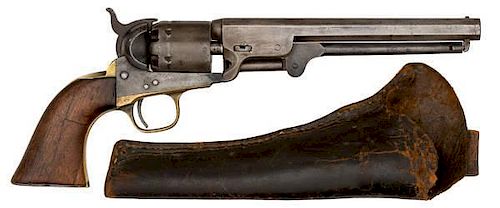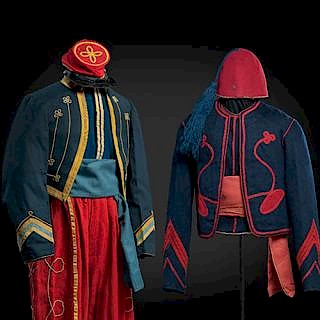Colt Model 1851 Navy Revolver Inscribed to George Maledon, Deputy Sheriff, Fort Smith, Arkansas
About Seller
6270 Este Ave.
Cincinnati , OH 45232
United States
With offices in Cincinnati, Cleveland and Denver, Cowan’s holds over 40 auctions each year, with annual sales exceeding $16M. We reach buyers around the globe, and take pride in our reputation for integrity, customer service and great results. A full-service house, Cowan’s Auctions specializes in Am...Read more
Two ways to bid:
- Leave a max absentee bid and the platform will bid on your behalf up to your maximum bid during the live auction.
- Bid live during the auction and your bids will be submitted real-time to the auctioneer.
Bid Increments
| Price | Bid Increment |
|---|---|
| $0 | $25 |
| $500 | $50 |
| $1,000 | $100 |
| $2,000 | $250 |
| $5,000 | $500 |
| $10,000 | $1,000 |
| $20,000 | $2,500 |
| $50,000 | $5,000 |
| $100,000 | $10,000 |
About Auction
Apr 29, 2015 - Apr 30, 2015
Cowan's Auctions dawnie@cowans.com
- Lot Description
.36 caliber, 7.5" octagonal barrel length, S/N 114206, matching. Marking on top of barrel "Address Col Saml Colt New-York U.S. America." Left side of frame is marked "Colts Patent." Inscription on the back of the backstrap "George Maledon" over "Deputy Sheriff Fort Smith Ark." Six-shot cylinder with attached loading lever. Case color frame, hammer and lever. Blue barrel with brass triggerguard and backstrap. One-piece walnut grips. Comes with leather "Slim Jim" style holster. A documented history also comes with this lot.
"The Prince of Hangmen," George Maledon was the official hangman for the United States Court at Fort Smith, Arkansas from 1872 to 1894. Over the course of 22 years as the official hangman, George Maledon executed over 60 men at the gallows in the gaol yards at Fort Smith. He also shot 3 other men for trying to escape from jail.
George was born on June 10, 1830 in Bavaria. In, 1831 George was brought to the United States with his family and settled in Detroit, Michigan. He was later trained as a machinist. Years later, in 1856, George moved to Fort Smith, Arkansas where he eventually was trained as an officer on the police force. On March 4, 1863, George enlisted in the 1st Battery, Arkansas Light Artillery as a Private. At the conclusion of the Civil War he returned to Fort Smith, Arkansas and was appointed to Deputy Sheriff.
From 1870 to 1871 the United States Court was transferred from Van Buren to Fort Smith, Arkansas. George was later appointed as Deputy US Marshall. In 1872, a request was approved allowing him to become the special executioner for Judge Isaac C. Parker of the Federal Court for the Western District of Arkansas at Fort Smith. From 1872 to 1894, a 22-year career as an executioner, George hanged 60 men at Fort Smith. In 1894, he resigned as the executioner. After a brief time in the private sector, George toured the South-West as "The Prince of Hangmen" showing off his collection of nooses and other relics from his days as an executioner. In his later years, George was admitted to the Mountain Home, a home for Volunteer Soldiers. With his health declining, he died on May 6, 1911 of natural causes and was laid to rest at the Mountain Home National Cemetery in Tennessee.The barrel has a gray patina with minor salt and pepper pitting. The markings on the barrel are sharp and crisp. The frame, cylinder loading lever, hammer and trigger have a gray patina with minor salt and pepper pitting. The trigger guard and backstrap have a mustard patina with some wear. The inscription on the back is very sharp and crisp. Grips have normal nicks and dings from use. On the right side of grips is a period repair. Bore is pitted in the grooves. Strong rifling. Leather holster is good with wear at the top from pulling revolver in and out. Some cracking near the edges.Condition
- Shipping Info
-
SHIPPING. At the request of the buyer, Cowan's will authorize the shipment of purchased items. Shipments usually occur within two weeks after payment has been received. Shipment is generally made via UPS Ground service. Unless buyer gives special instructions, the shipping method shall be at the sole discretion of Cowan's Auctions, Inc.. Cowan's is in no way responsible for the acts or omissions of independent handlers, packers or shippers of purchased items or for any loss, damage or delay from the packing or shipping of any property.
-
- Buyer's Premium



 EUR
EUR CAD
CAD AUD
AUD GBP
GBP MXN
MXN HKD
HKD CNY
CNY MYR
MYR SEK
SEK SGD
SGD CHF
CHF THB
THB


















